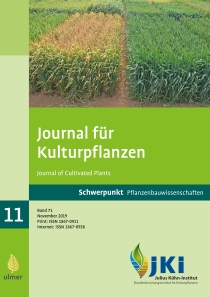A MAGIC population as an approach to the conservation and development of genetic diversity of winter barley for breeding purposes by on-farm management
DOI:
https://doi.org/10.5073/JfK.2019.11.02Keywords:
MAGIC population, evolutionary bulk, winter barley, genetic resources, sustainable agricultural production systemAbstract
Additional genetic diversity in crop breeding programmes and in crop production is required to better cope with the impact of climate change. To complement ongoing activities of winter barley breeders, an evolutionary plant breeding programme has been initiated in 2008. Out of 227 German winter barley varieties released between 1914 and 2003, a set of 58 varieties was genetically analysed using SSR markers. Among these, 32 genotypes representing the genetic diversity of the whole set were crossed according to the Multi-parent Advanced Generation Inter-Cross scheme (MAGIC) over six generations. The resulting 324 lines were combined to form a heterogeneous MAGIC winter barley population. In order to adapt to regional agricultural conditions, MAGIC sub-populations are currently being cultivated within a network of 12 eco-geographically contrasting locations and subjected to natural site-related selection as evolutionary bulks. Cultivation and seed saving will take place over a period of 6 to 8 years under high and low input production conditions. An information system named ROBUSTUM has been developed for consistent recording of cultivation conditions, of characterisation and evaluation data as well as for documentation of the pedigree and for subsequent data analyses. The present approach enables a continuous and dynamic adaptation of the natural genetic diversity present in our crops to climatic and site-related agronomic changes. This makes the evolutionary bulk particularly suitable for organic cultivation, but also for marginal sites and locations with unfavourable soil and weather conditions. In view of increasingly extreme climatic conditions, these properties may become even more important for agriculture in the future. Populations also contribute to the maintenance and development of a genetic diversity as broad as possible. This approach enables estimation of the potential of evolutionary bulks to contribute to the development of sustainable agricultural production systems.








